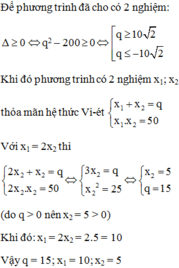1.a.Phương trình : x2 - 7x + q = 0 , biết hiệu hai nghiệm bằng 11 . Tìm q và 2 nghiệm của phương trình .
b. Tìm q và hai nghiệm của PT : x2 - qx + 50 = 0 , biết PT có 2 nghiệm và có 1 nghiệm bằng 2 lần nghiệm kia
2. Cho x1 = 3 ; x2 = 2 lập một hệ phương trình bậc hai chứa hai nghiệm trên
3. Tìm 2 số a và b biết tổng S = a+b = -3 và tích P = ab = -4




1a. \(x^2-7x+q=0\)
\(\Delta=b^2-4ac=\left(-7\right)^2-4.1.q=49-4q\)
Hai nghiệm của pt: \(x_1=\dfrac{-b-\sqrt{\Delta}}{2a}=\dfrac{-\left(-7\right)-\sqrt{49-4q}}{2.1}=\dfrac{7-\sqrt{49-4q}}{2}\);
\(x_2=\dfrac{-b+\sqrt{\Delta}}{2a}=\dfrac{-\left(-7\right)+\sqrt{49-4q}}{2.1}=\dfrac{7+\sqrt{49-4q}}{2}\)Ta có \(x_2>x_1;x_2-x_1=11\) => \(\dfrac{7+\sqrt{49-4q}}{2}-\dfrac{7-\sqrt{49-4q}}{2}=11\)
\(\Leftrightarrow\dfrac{7+\sqrt{49-4q}-7+\sqrt{49-4q}}{2}=11\)
\(\Leftrightarrow2\sqrt{49-4q}=22\)
\(\Leftrightarrow\sqrt{49-4q}=11\)
\(\Leftrightarrow49-4q=121\)
\(\Leftrightarrow q=-18\)
=> \(x_1=\dfrac{7-\sqrt{49-4.\left(-18\right)}}{2}=-2\); \(x_2=\dfrac{7+\sqrt{49-4.\left(-18\right)}}{2}=9\)
Vậy q=-18;x1=-2;x2=9.
b. Tương tự nhé :v
2. \(x_1=3;x_2=2\Rightarrow\left\{{}\begin{matrix}S=3+2=5\\P=3.2=6\end{matrix}\right.\)
Hai nghiệm trên là nghiệm của phương trình: \(x^2-Sx+P=0\)
\(\Rightarrow x^2-5x+6=0\)
3. Hai số a và b có tổng S=-3; P=-4
=> a và b là hai nghiệm của phương trình \(x^2-Sx+P=0\Rightarrow x^2+3x-4=0\) (*)
Ta có: \(a+b+c=1+3-4=0\)
=> PT (*) có 2 nghiệm \(x_1=1;x_2=\dfrac{c}{a}=-\dfrac{4}{1}=-4\)
Vậy a=1;b=-4